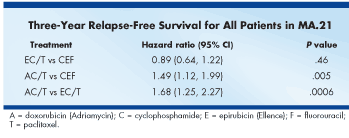Canadian Breast Chemo Regimen May Be Superior to AC/T
The standard treatment for early breast cancer—AC/T— was not as effective as two regimens used in Canada in preventing recurrences. Specifically, CEF and a novel regimen, dose-dense EC/T, were both more effective than AC/T in the MA.21 study
• SAN ANTONIO The standard treatment for early breast cancerAC/T was not as effective as two regimens used in Canada in preventing recurrences. Specifically, CEF and a novel regimen, dose-dense EC/T, were both more effective than AC/T in the MA.21 study, reported by Margot Burnell, MD, at the 29th Annual San Antonio Breast Cancer Symposium (abstract 53). "This clinical trial may change the way many patients with breast cancer are treated in the future," said Dr. Burnell, an oncologist from Saint John, New Brunswick.
The MA.21 study was funded by the Canadian Cancer Society and coordinated by the National Cancer Institute of Canada (NCIC) Clinical Trials Group. The aim was to incorporate a taxane into an epirubicin (Ellence)-containing regimen and to compare this to existing standard regimens. The trial involved 2,105 women in Canada and the United States, all under the age of 60 and either premenopausal or early postmenopausal, with lymph-node-positive or high-risk node-negative breast cancer. After surgery, the women were randomized to one of three 6-month regimens:
• AC/T: Four cycles of Adriamycin 60 mg/m2 and cyclophosphamide 600 mg/m2 every 3 weeks, followed by paclitaxel 175 mg/m2 every 3 weeks.
• CEF: Six cycles of cyclophosphamide 75 mg/m2 on days 1 to 14, plus epirubicin 60 mg/m2 and fluorouracil 500 mg/m2 on days 1 to 8, with antibiotics.
• EC/T (dose-dense): Six cycles every 2 weeks of epirubicin 120 mg/m2 and cyclophosphamide 830 mg/m2 plus filgrastim (G-CSF, Neupogen) and epoetin alfa (Epogen, Procrit), followed by four cycles of paclitaxel 175 mg/m2 every 3 weeks.
ER/PR-positive postmenopausal patients could take tamoxifen and aromatase inhibitors (after 2004); radiation was allowed postlumpectomy; and trastuzumab (Herceptin) (after June 2005) 6 months after completion of chemotherapy. Median follow-up was 30.4 months. By Oct. 2006, 261 events had occurred.
An interim analysis showed the 3-year recurrence-free survival rates to be 85% with AC/T, compared with 90.1% for CEF and 89.5% for dose-dense EC/T. Recurrences were experienced by 112 patients on AC/T, 79 patients on CEF, and 70 patients on EC/T. There was no significant difference between the two epirubicin-containing arms, but the differences between these arms and AC/T was significant (see Table).

When analyzed by ER status, the differences between the regimens were significant only in ER-negative patients. In these patients, the hazard ratio for AC/T vs CEF was 1.67 (P = .007), and for AC/T vs EC/T 2.15 (P = .0002).
Toxicity was higher with CEF and EC/T, compared with AC/T. Febrile neutropenia occurred in 22.9% on CEF and 16.7% on EC/T vs 4.8% on AC/T. Cardiotoxicity grade 1-2 was seen in 34.8%, 28.0%, and 21.5%, respectively, while grade 3-4 occurred in 2.0%, 0.7%, and 0.4%. Acute thromboembolic events were observed in 7.7%, 7.8%, and 2.0%.
The investigators concluded that AC/T every 3 weeks is significantly inferior to CEF or EC/T in terms of relapse-free survival in patients with high-risk breast cancer. "Taxane-based chemotherapy may not be necessary in all women receiving adjuvant chemotherapy," Dr. Burnell said. "The role of non-dose-dense taxane-based chemotherapy is unclear. A dose-dense/dose-intense approach with anthracyclines adds benefit in this setting. As for the two epirubicin arms, it is too early to detect any differences between CEF and dose-dense EC/T."
It was pointed out that AC/T given every 2 weeks may have produced better outcomes than the every-3-week regimen used in this trial. However, Kent Osborne, MD, of Baylor College of Medicine, Houston, noted "at the time the study was designed, the dose-dense schedule was not well established. The surprising finding was that CEF performed as well as it did. This suggests that there is an alternative regimen for us to use."
Newsletter
Stay up to date on recent advances in the multidisciplinary approach to cancer.